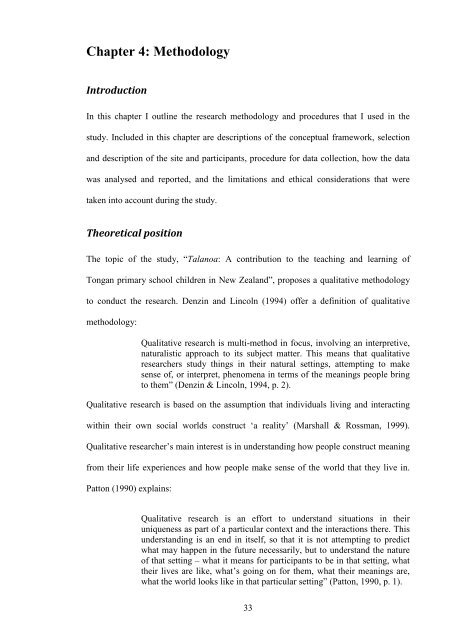Talanoa - Scholarly Commons Home
Talanoa - Scholarly Commons Home
Talanoa - Scholarly Commons Home
You also want an ePaper? Increase the reach of your titles
YUMPU automatically turns print PDFs into web optimized ePapers that Google loves.
Chapter 4: Methodology<br />
Introduction<br />
In this chapter I outline the research methodology and procedures that I used in the<br />
study. Included in this chapter are descriptions of the conceptual framework, selection<br />
and description of the site and participants, procedure for data collection, how the data<br />
was analysed and reported, and the limitations and ethical considerations that were<br />
taken into account during the study.<br />
Theoretical position<br />
The topic of the study, “<strong>Talanoa</strong>: A contribution to the teaching and learning of<br />
Tongan primary school children in New Zealand”, proposes a qualitative methodology<br />
to conduct the research. Denzin and Lincoln (1994) offer a definition of qualitative<br />
methodology:<br />
Qualitative research is multi-method in focus, involving an interpretive,<br />
naturalistic approach to its subject matter. This means that qualitative<br />
researchers study things in their natural settings, attempting to make<br />
sense of, or interpret, phenomena in terms of the meanings people bring<br />
to them” (Denzin & Lincoln, 1994, p. 2).<br />
Qualitative research is based on the assumption that individuals living and interacting<br />
within their own social worlds construct ‘a reality’ (Marshall & Rossman, 1999).<br />
Qualitative researcher’s main interest is in understanding how people construct meaning<br />
from their life experiences and how people make sense of the world that they live in.<br />
Patton (1990) explains:<br />
Qualitative research is an effort to understand situations in their<br />
uniqueness as part of a particular context and the interactions there. This<br />
understanding is an end in itself, so that it is not attempting to predict<br />
what may happen in the future necessarily, but to understand the nature<br />
of that setting – what it means for participants to be in that setting, what<br />
their lives are like, what’s going on for them, what their meanings are,<br />
what the world looks like in that particular setting” (Patton, 1990, p. 1).<br />
33

















